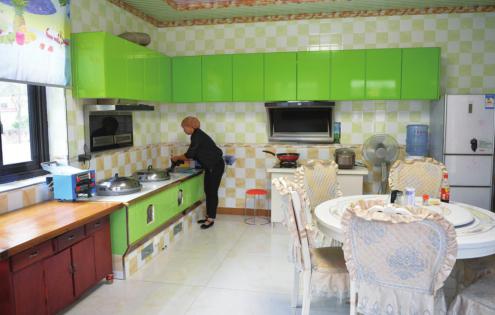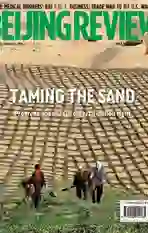Reflection of Progress
2018-09-19
Researchers check the surface of a four-meter-aperture optical mirror developed by the Changchun Institute of Optics, Fine Mechanics and Physics of the Chinese Academy of Sciences in northeast Chinas Jilin Province on August 21.
The optical mirror is an important tool for deep space and astronomical observation. The silicon carbide aspheric optical mirror measures 1.6 tons. The silicon carbide used in production provides more stability to the surface of the mirror, allowing for greater accuracy at 20 nanometers.
Publicity Work
President Xi Jinping has underscored the importance of better fulfi lling the tasks of publicity and ideological work.
Xi, also General Secretary of the Communist Party of China (CPC) Central Committee and Chairman of the Central Military Commission, made the remarks while addressing a national conference on publicity and ideological work held in Beijing on August 21-22.
He called for publicity and ideological work to unite the people to embrace shared ideals, convictions, values and moral standards, thus making greater contributions to the Party and state.
Xi said that decisions and plans made by the CPC Central Committee since the 18th CPC National Congress in 2012 are correct and that offi cials in areas related to publicity and ideological work are reliable.
He called for “unity of thinking and gathering strength” to be the central premise of publicity and ideological work.
In order to better carry out publicity and ideological work under the new circumstances, Xi underlined the importance of holding high the banner of Marxism and socialism with Chinese characteristics.
Xi stressed being fi rm on maintaining the right tone in public communication to boost morale and raise peoples spirits in the Party and across the country.
He called for efforts to promote socialist cultural and ethical progress, and cultivate and observe core socialist values to foster a new generation capable of shouldering the mission of national rejuvenation.
He also placed emphasis on adhering to the path of socialist cul- ture with Chinese characteristics and developing a great socialist culture in China.
“We will improve our ability to engage in international communication so as to tell Chinas stories well, make Chinas voice better heard, and present a true, multi-dimensional and panoramic view of China to the world,” Xi said.
Developing a socialist ideology that has the ability to unite and the power to inspire the people is a strategic task for the whole Party, especially those on the publicity and ideological front, Xi noted.
People who work in the art and culture sectors should continue to produce masterpieces that laud the Party, the motherland, the people and the heroes, he said.
Noting that Chinas traditional culture serves as the cultural foundation of the Chinese nation, Xi said that its vision, concepts, values and moral norms not only constitute the ideological and spiritual core of China but can also prove valuable in addressing the issues faced by all of humanity.
Xi also emphasized enhancing overall Party leadership in publicity and ideological work.
Wang Huning, a member of the Standing Committee of the Political Bureau of the CPC Central Committee and a member of the Secretariat of the CPC Central Committee, presided over the meeting.
Wang noted that Xis speech should be the guideline for the Partys publicity and ideological work under the new circumstances.
In his closing speech at the meeting, Huang Kunming, a member of the Political Bureau of the CPC Central Committee and head of the Publicity Department of the CPC Central Committee, pledged to thoroughly implement the instructions given by Xi for publicity and ideological work.
Poverty Alleviation
Chinas Ministry of Civil Affairs on August 22 unveiled new measures to support the fi ght against poverty.
These include strengthening support for social welfare, mobilizing non-governmental organizations, volunteers and philanthropists to join the anti-poverty campaign, improving subsidies for people with disabilities, providing better care for the elderly and left-behind children in rural areas, and improving community-level governance and its oversight.
The measures were announced by Civil Affairs Minister Huang Shuxian at a national teleconference, who called on civil affairs officials at all levels to further cut red tape and prevent corruption while increasing the efficiency and transparency of work.
The Chinese leadership has pledged to win the battle against poverty in less than three years. According to the plan, by the year 2020, all rural residents will have been lifted out of poverty.
Gambling Bust
Police have busted a transnational Internet gambling ring involving around 7.8 billion yuan ($1.1 billion).
Some 56 suspects, who allegedly earned illegal profi ts of 650 million yuan ($94.8 million), have been arrested, according to police in east Chinas Jiangsu Province.
An investigation into the case was launched in January 2016 after police received information about a gambling website.
The online platform was opened in the Philippines and had more than 114,000 users.
Police identifi ed four prime suspects through bankcard information.
Two website technicians, who had been operating the website in the Philippines, were arrested in Shanghai in 2017. Police then gained access to backend data and the structure of the group.
As of August, 50 suspects had been arrested in Shanghai and Fujian, Zhejiang and Guangdong provinces. Six others returned to China from the Philippines and turned themselves in.
The suspects are being transferred to the local procuratorate for prosecution.
Train of Thought
Students are shown a steam locomotive in Jinan, east Chinas Shandong Province, on August 21. The Jinan Locomotive Depot promotes primary school students knowledge of the history of Chinese modern railway development as part of their summer vacation.
Internet Court
Chinas fi rst court specializing in Internet-related incidents has handled more than 11,000 cases since its inception a year ago, according to the court itself.
The Hangzhou Internet Court, located in the e-commerce hub of Hangzhou, capital of southeast Chinas Zhejiang Province, was set up on August 18 last year to cope with increasing online disputes in a country with nearly 800 million Internet users by the end of 2017.
It mainly handles civil cases such as contract disputes involving online shopping, service and small loans, copyright and infringement lawsuits, domain name disputes, Internet defamation, and some administrative lawsuits.
The court has concluded more than 9,600 cases and the average duration of a trial is 38 days, around 50 percent shorter than conventional courts.
The court is also setting up a data center for Internet-related cases, according to Du Qian, Chief J ustice of the court.
Following Hangzhous lead, China plans to set up Internet courts in Beijing and Guangzhou, the Supreme Peoples Court announced in July.
Smart Farming
A staff member operates a machine to control water and fertilizer in the greenhouse of an agriculture garden in Raoyang County, north Chinas Hebei Province, on August 22. In recent years, Raoyang County has focused on introducing modern technology to promote agricultural development.

Live-Streaming Regulation
Chinese authorities will enhance the regulation of live-stream services, the National Offi ce Against Pornographic and Illegal Publications (NOAPIP) said on August 20.
A notice was jointly issued by six departments, namely the NOAPIP, the Ministry of Industry and Information Technology, the
Ministry of Public Security, the Ministry of Culture and Tourism, the State Administration of Radio and Television, and the State Internet Information Offi ce, said a NOAPIP statement.
The notice clarifi es the responsibilities of live-stream service providers, network service providers and application stores.
Live-stream service providers should complete the Internet Content Provider (ICP) fi ling, gain certifi cates for news services, online shows and live streams, and report to local police within 30 days after a show is broadcast.
The notice requires service providers to better implement realname registration of live-stream viewers, blacklist live-stream anchors who violate regulations and enhance the supervision of live-stream content.
The live-streaming industry has been highlighted in operations targeting online pornographic content launched since February.
Chinese Countermeasures
Chinas tariffs on $16 billion worth of U.S. goods took effect at 12:01 p.m. Beijing Time, at the same time that the United States implemented additional 25-percent tariffs on a similar amount of Chinese goods at 12:01 a.m. EDT (0401 GMT) on August 23, according to the Customs Tariff Commission of the State Council.
The U.S. tariff list includes commodities such as semiconductors, electronics, plastics, chemicals and railway equipment, while Chinas tariff list covers automobiles, energy and chemical raw materials.
China strongly opposes the U.S. move of imposing additional tariffs on Chinese goods and is forced to fi ght back, according to a statement by the Ministry of Commerce(MOFCOM) on August 23.
Moreover, China will fi le a complaint with the World Trade Organization (WTO) against the U.S. tariffs under a Section 301 investigation, MOFCOM announced.
By initiating the complaint under the WTO dispute settlement mechanism, China demonstrates its intent to safeguard free trade and multilateral mechanisms as well as its legitimate rights and interests, a MOFCOM spokesperson said in an online statement.
By willfully imposing the tariffs on August 23, the United States has clearly violated WTO rules, according to the statement.
“China fi rmly opposes this and has to once again take the necessary countermeasures,” it said.
The latest action brings the value of Chinese imports subjected to tariffs to $50 billion after $34 billion of Chinese goods were hit with duties on July 6.
ODI Growth
Chinas non-fi nancial outbound direct investment (ODI) continued its steady growth in the fi rst seven months of the year, according to offi cial data.
Chinese investors made $65.27 billion of non-fi nancial ODI in nearly 4,000 overseas enterprises across 152 countries and regions from January to July, the Ministry of Commerce said. It marked a 14.1-percent increase from the same period a year ago.
ODI in countries along the China-proposed Silk Road Economic Belt and 21st-Century Maritime Silk Road rose 11.8 percent from a year earlier to $8.55 billion.
The structure of outbound investment improved, with investment mainly in the leasing and business service, retail and wholesale, manufacturing and mining sectors. No new projects were reported in sectors such as property development, sports and entertainment.
Chinese contractors signed more agreements for large projects abroad in the fi rst seven months. Transport, power and construction projects accounted for more than two thirds of the total contract value, and around 85 percent of new projects saw their contract value surpass$50 million.
A ministry index that measures ODI activity each month remained stable at 192.93 in July, compared with a peak of 205.3 and a low of 189.6 in the fi rst seven months.
Out to Dry
A farmer dries rice in the sun in Chiyan Village near Chishui City, southwest Chinas Guizhou Province, on August 16.
Global Metro City
The city of Chengdu in southwest Chinas Sichuan Province has been ranked the third highest performing city in terms of economic growth in the Brookings Institutes 2018 Global Metro Monitor report.
The Brookings Institute, an American public policy think tank, looked at the Gross Domestic Product (GDP), per-capita GDP, Purchasing Power Parity, employment and population of the 300 largest metropolitan economies. The report said that these areas account for 36 percent of global employment growth and 67 percent of global GDP growth.
Metropolitan areas in China and parts of the Asia-Pacifi c experienced the fastest growth in per-capita GDP growth, whereas those in the Middle East and Africa exhibited the fastest growth in employment.
Chengdu is a rising star in the rankings, with employment growth of 5.9 percent and per-capita GDP growing at 7.2 percent, coming in at third place in the overall rankings behind Dublin and San Jose.
Of the top 30 cities in the index of economic performance from 2014 to 2016, 17 are in China. Second-tier cities are relatively strong performers in the rankings, as middle-income cities can achieve a relatively large increase in growth quickly thanks to a lower starting point compared with larger established urban centers.
Back in 2012, when the Brookings Institute ranked the worlds cities according to the size of their economy, only 48 cities in China made the list of 300. According to this years report, 103 cities in China were on the list, exceeding the number in North America and Western Europe.
Fungus Fortune
A worker handles macrolepiota albuminosa at a workshop in Macheng Town in Xuyong County, southwest Chinas Sichuan Province, on August 21. The production and processing of macrolepiota albuminosa, a species of agaric fungus that grows on decomposed wood, has become an important industry in the county, helping villagers alleviate poverty.
NEV Policies
China is more swiftly releasing a package of policies to enhance the competitiveness of its new-energy vehicle (NEV) sector, the Economic Information Daily reported on August 20.
Policymakers are considering new regulation on auto industry investment, the newspaper cited sources with the National Development and Reform Commission (NDRC) as saying.
Under the new regulation, new manufacturers of electric vehicles are required to have a minimum annual production capacity of 100,000 units, while sustainable development capacity will be a must.
Tighter restrictions on diesel and petrol cars will be highlighted in the“most draconian” policy, including suspending new projects and limiting capacity expansion, according to the newspaper.
NDRC offi cial Cai Ronghua said that more will be done to facilitate the development of smart NEVs, referring to plans to create a favorable environment for intelligent vehicles.
China has been the worlds largest NEV market for three consecutive years, with some 777,000 vehicles sold in 2017.
In the fi rst seven months of 2018, Chinas NEV production rose 85 percent year on year to 504,000 units, while sales jumped 97.1 percent to 496,000 units, according to the China Association of Automobile Manufacturers.
Private School Financing
China plans to allow fi nancial institutions to develop products suitable for private schools in a move to advance private education.
Private schools can apply for fi nancing from fi nancial institutions using future operating income and intellectual property rights as a guarantee, according to a draft amendment to the regulation regarding private education. The regulation has been published by the Ministry of Justice for the public to provide opinions on until September 10.
Foundations and other corporate forms of for-profi t private schools can apply for fi nancing using their own assets or services provided for schools as a guarantee, said the draft.
For-profi t private schools can be established with funds raised through issuing shares and bonds and setting up public welfare funds, according to the Ministry of Education.
Room at the Inn
A villager cleans a kitchen counter at a family inn in Yongxin Village, Wuzhong City, northwest Chinas Ningxia Hui Autonomous Region, on August 21. More than 20 households in the village have opened family guesthouse businesses since 2017.
Global Yuan Usage
International usage of the renminbi, or yuan, the Chinese currency, remains stable despite a sharp fall in the offshore exchange rate, according to a new report by Bank of China (BOC).
In June, the yuan remained in 5th place in the currency rankings for global payments, with a share of 1.81 percent, BOC said in its Offshore RMB Express report citing data from SWIFT, a global fi nancial institution network.
Currently, Hong Kong is the key offshore market for yuan payments, accounting for 75.98 percent of the renminbi trading volume.
Total turnover via the Real Time Gross Settlements (RTGS) clearing system reached 21.46 trillion yuan($3.14 trillion), up 10 percent month on month and 38.7 percent year on year, the report showed.
The opening of Chinas domestic capital market continues at a steady pace, BOC said.
As of July 31, the quota in the RMB Qualifi ed Foreign Institutional Investor (RQFII) program came in at 622.1 billion yuan ($91 billion), data from the State Administration of Foreign Exchange showed.
So far, 19 countries and regions have obtained RQFII quotas, totaling 1.94 trillion yuan ($283 billion), according to the report.
